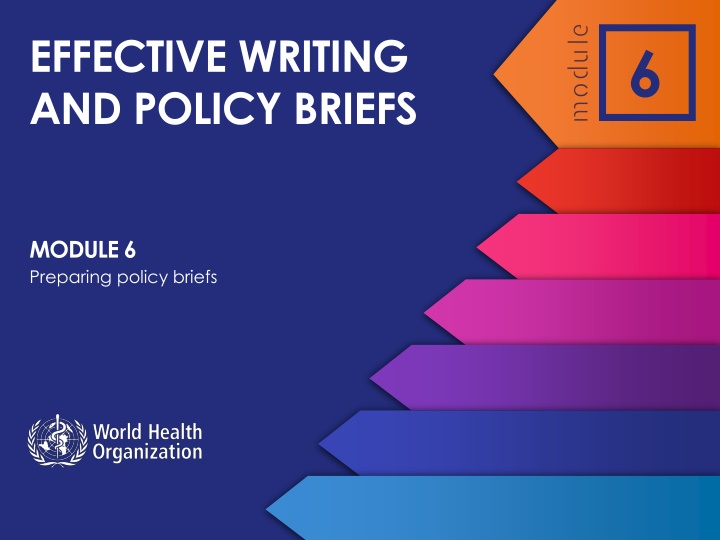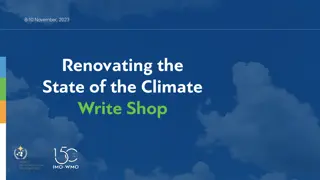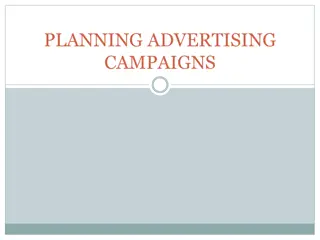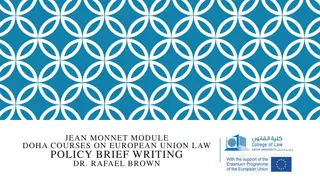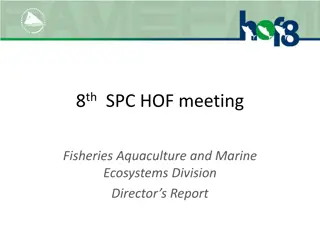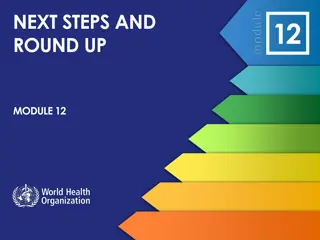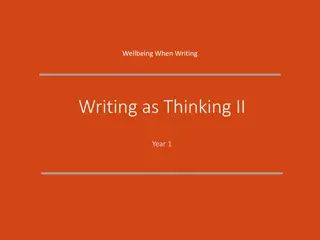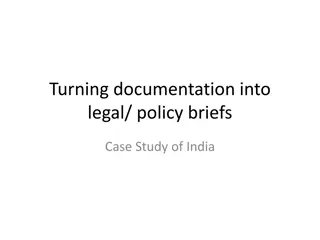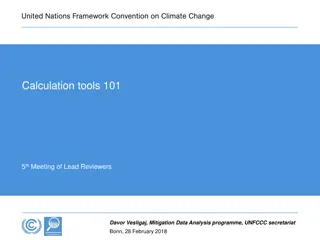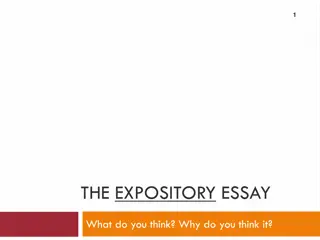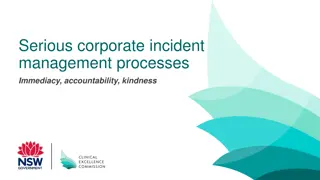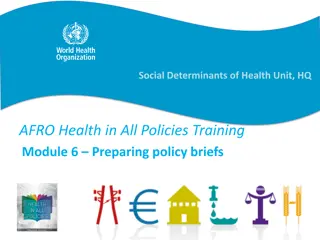Effective Writing and Policy Briefs: Enhancing Impact in Policy-making
A policy brief is a compelling document designed to influence decision-makers by outlining policy alternatives and courses of action. Discover the value of policy briefs, effective characteristics, and strategies for agenda setting and policy formulation in this comprehensive module.
Download Presentation

Please find below an Image/Link to download the presentation.
The content on the website is provided AS IS for your information and personal use only. It may not be sold, licensed, or shared on other websites without obtaining consent from the author.If you encounter any issues during the download, it is possible that the publisher has removed the file from their server.
You are allowed to download the files provided on this website for personal or commercial use, subject to the condition that they are used lawfully. All files are the property of their respective owners.
The content on the website is provided AS IS for your information and personal use only. It may not be sold, licensed, or shared on other websites without obtaining consent from the author.
E N D
Presentation Transcript
EFFECTIVE WRITING AND POLICY BRIEFS 6 MODULE 6 Preparing policy briefs
LEARNING OBJECTIVES 6 Explain the purpose of a policy brief in the context of policy-making 1 Summarize characteristics of effective writing and influential policy briefs 2 Describe three common approaches to prioritizing health in policy discourses 3
WHAT IS A POLICY BRIEF? 6 A policy brief is a document which outlines the rationale for choosing a particular policy alternative or course of action in a current policy debate. A vehicle for providing advice: Convince the target audience of the urgency of the current problem; and Persuade the target audience to adopt the preferred course of action A medium for exploring an issue and distilling lessons learned from the research.
POLICY BRIEFS AGENDA SETTING AND POLICY FORMULATION 6 REVIEW AGENDA SETTING Report Identify problem Evaluate Research Monitor Set agenda IMPLEMENTATION FORMULATION Enforce policy Develop options and strategies Implement policy Negotiate Formulate policy
6 WHAT IS THE VALUE OF POLICY BRIEFS? Windows of opportunity are critical opportunities for addressing important policy problems. It is essential to be prepared and have the groundwork laid in order to seize and advance a policy agenda. Whilst policy briefs can seem rather routine documents, they have the potential to directly influence a decision- maker and can thus be a critical tool.
CHARACTERISTICS OF EFFECTIVE POLICY BRIEFS 6 1 Focus 2 Policy-minded rather than academic 3 Strong evidence 4 Limited scope 5 Succinct 6 Understandable 7 Accessible Promotional 8 Practical and feasible 9
CHARACTERISTICS OF EFFECTIVE POLICY BRIEFS 6 1 Focus Need to strategically focus on achieving the intended goal of convincing the target audience.
CHARACTERISTICS OF EFFECTIVE POLICY BRIEFS 6 2 Policy-minded rather than academic The common audience of policy briefs are interested in what you found and what you recommend. They do not need to know the details of the methodology. Focus on meanings, not methods.
CHARACTERISTICS OF EFFECTIVE POLICY BRIEFS 6 3 Strong evidence Policy briefs should be based on firm evidence and a rational argument. The information (drawing on the evidence) should identify that a problem exists and the consequences of adopting particular alternatives.
CHARACTERISTICS OF EFFECTIVE POLICY BRIEFS 6 4 Limited scope The policy brief should focus on a particular problem or issue. Do not go into all the details. Instead, provide enough information for the reader to understand the issue and come to a decision.
CHARACTERISTICS OF EFFECTIVE POLICY BRIEFS 6 5 Succinct Be short and to the point. Remember your target audience.
CHARACTERISTICS OF EFFECTIVE POLICY BRIEFS 6 6 Understandable The policy brief is easy to read and appears interesting. There is a well explained and easy to follow argument.
CHARACTERISTICS OF EFFECTIVE POLICY BRIEFS 6 7 Accessible Ensure the information in the policy brief is easy to navigate. Text should be subdivided using clear descriptive titles.
CHARACTERISTICS OF EFFECTIVE POLICY BRIEFS 6 8 Promotional The policy brief should look attractive and grab the reader s attention. Consider the use of colour, graphics and photographs.
CHARACTERISTICS OF EFFECTIVE POLICY BRIEFS 6 9 Practical and feasible The policy brief needs to be realistic. The target audience will be more interested in recommendations they can implement that are politically, economically, socially and technically feasible.
6 STRUCTURE OF POLICY BRIEFS 1 Executive summary 2 Context and importance of the problem 3 Critique of policy option(s) 4 Policy recommendation 5 Appendices
6 STRUCTURE OF POLICY BRIEFS 1 Executive summary Aims to convince the reader that the brief is worth in-depth investigation and warrants further reading. Distil the essence of the brief. Ask yourself, What are the main points you want to get across?
6 STRUCTURE OF POLICY BRIEFS 2 Context and importance of the problem Explain the significance/urgency of the issue. The problem (What is the problem? Why is it important? Explain the policy relevance of the issue) Context (What happens, where, who is involved?) Causes of the current situation (Why? Give evidence or examples) Effects of current situation (What effect does it have? Give evidence or examples) The reader needs to be convinced early on that the problem warrants action.
6 STRUCTURE OF POLICY BRIEFS 3 Critique of policy option(s) Here is where you focus on detailing the shortcomings of the current approach or options being implemented. Explain why and how the current or proposed approach is failing. Illustrate the need for change.
6 STRUCTURE OF POLICY BRIEFS 4 Policy recommendations Describe clearly what should happen next. Provide a detailed and convincing proposal of how the failings of the current policy approach need to be addressed. Suggest revisions in policy. What are the various options? Effects of the revised policy. How will the policy changes improve the situation?
6 STRUCTURE OF POLICY BRIEFS 5 Appendices Authors sometimes decide that their argument needs further support and so include an appendix.
End of Module 6 Please continue to Module 7 Part 1
